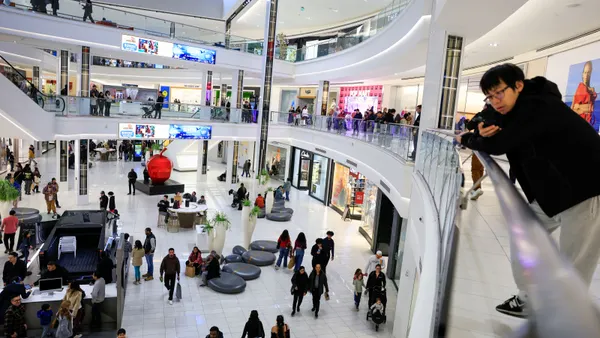Dive Brief:
-
Department store consolidation, a shift to services, growing online apparel sales, the aging of millennials and growth in nontraditional channels like rental and subscriptions are the five major forces reshaping malls, according to retail think tank Coresight Research.
-
More than 1,000 department stores will close between now and 2023, reducing the total footprint by one fifth, which will hit lower-traffic, lower-sales regional malls more than higher-traffic premium ones, according to the report. Meanwhile brick-and-mortar apparel sales will remain flat, as shoppers spend some $73 billion more online for clothes in 2023, or a third of the total, up from 20% today.
-
More than half of U.S. consumers by then will be either millennials or Gen Z, who will continue to prioritize value and experiences and will increasingly buy (or rent) online, Coresight said. Between 2000 and 2017, consumer discretionary spending on goods fell from 50% to just over 45%, which means that Americans spent $139 billion less on discretionary goods last year than they would have if the goods/services split were at the level it was 17 years ago, according to the report.
Dive Insight:
Amidst a correction of a decades-long overbuilding of malls in the U.S., are shifts in spending channels, habits and priorities that are spurring a dramatic makeover of the retail format. The paradigm of specialty apparel stores anchored by department store is giving way to a more diverse mix of non-apparel retailers, leisure and entertainment businesses, event and pop-up spaces and service providers, according to Coresight's report.
In the meantime, "unexceptional" regional malls dominated by apparel will face the most extreme challenges, warned Coresight CEO and founder Deborah Weinswig.
"Many forward-thinking mall operators and real estate owners are already reshaping their tenant mixes," she said in a statement emailed to Retail Dive. "Those property firms that are proactively dealing with market shifts by broadening their range of tenants now — rather than simply reacting to apparel store closure programs and bankruptcies as they arise — look set to be the most resilient as the apparel market shifts further."
The Coresight findings jibe with another report from global strategy and management consulting firm A.T. Kearney, which earlier this year found that the over-saturation doesn't mean new malls won't be built, just that they must be re-imagined as "consumer engagement spaces" that cater to consumers "less interested in owning things than in having experiences and accessing functionalities."
And while not all will be so massive, "American Dream Miami," a shopping center being developed by Canadian conglomerate Triple Five, will feature shops, restaurants, hotel accommodations and amusement park amenities like an indoor ski slope and demonstrates the new wave of malls on the horizon.
"To those who read headlines of a retail apocalypse, it may seem counterintuitive to be opening malls," Coresight Senior Analyst John Mercer told Retail Dive in an email. "But what we are really seeing is an accelerated— and, in some cases, belated — evolution of retail. These kinds of experiential, destination malls resonate with where leisure shopping is headed: high-quality, experience-rich, multi-category centers with a substantial share of space taken by non-retail tenants."
The future holds promise for the kind of vision embodied in the planned Miami mall, though not all will be amusement parks. "We see physical stores clustering around several functions: convenience (last minute purchases), collection (BOPIS), discount (offline budget retail, such as off-price and grocery discounters) and destination (quality experiences for leisure shoppers)," Mercer said. "Centers such as American Dream Miami cater to the last of those four demands."














